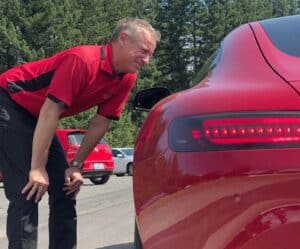The Art of Racing in the Rain
Essay by Don Kitch Jr.
Driving a racing car in the rain is a science mastered by knowledge and above all experience. I try to get out on a rain-soaked racetrack every chance I get. I find this helps build skills and confidence, so you are mentally and physically prepared for your inevitable rain race.
Driving Techniques
Racing in the rain mandates “smooth.” This is not a time to be throwing the car’s weight around, inducing uncontrolled skid and slide. Balance is critical. Remember your primary job description as a racecar driver, “you are a weight manager.” When I am in need of extremely smooth driving skills, I visualize my racecar as a bathtub full of water with four wheels on it. I see myself in the tub with water level now elevated right to the top. I try to drive my tub/racecar without spilling any water out the front, back, or sides. I picture blown eggshells on the pedals – don’t break the shells. The “squeeze on and ease off” application to the brake and gas pedal is critical.
Be smooth with your gear changes. Try going one gear higher in the turns than you normally would, using third gear where you would normally use second. This will lessen the chance of severe wheel spin by reducing the amount of torque to the drive wheels.
Aquaplaning is one of the trickiest parts of racing in the rain when the tire cannot cut through the buildup of water on the track surface, and it begins to skim across the top of the water. The trick to controlling aquaplaning is to do as little as possible, be gentle. Aquaplaning is like driving on ice, the less you do, the better your chances of surviving. Do not “jump” off the throttle, as the sudden suspension unload and compression braking of the engine will cause the forward transfer of weight and cause rear wheels to slip. Under no circumstances should you go to brakes. Keep the steering wheel pointed straight. Here is why—consider aquaplaning equal to skimming across the top of a puddle. If the front wheels are turned at an angle when you reach the other side of the puddle, they will now regain traction, while the rears are still on top of the puddle with no traction. The front end of the car will now follow the front tires, and the back end is going to skid sideways causing a spin-out.
The general rule in rain driving is to drive where everyone else hasn’t. In other words, off the ideal line. The idea is to look for, and use, the grippiest pavement. Through the years of cars driving over a particular part of the track, the surface becomes polished smooth and the pores in the pavement are packed with rubber and oil. That is exactly where you don’t want to be in the rain. You want to search out the granular, abrasive surface. This can sometimes mean driving around the outside of a corner, or hugging the inside, or even crossing back and forth across the normal line. I use the pace lap or my out lap of practice to look for the grippiest pavement and identify locations of standing water.
Finally, in the event of a full spinout, lock up the brakes. Many times, the impact can be avoided or minimized by slowing a spinning car down by the full application of brakes.
Driver and Car Preparation
Racing is a business of organization and being prepared. Personal and car preparation for a rain race needs to be started as we become aware a wet race is imminent.
Your chassis/suspension setup may have to be changed for the rain. Generally, you want to run a softer car: softer springs, shocks, and antiroll bars. (In fact, many drivers disconnect the antiroll bars entirely in the rain.) this will help your overall grip while giving you more feel for what the car is doing. If possible, since there will be less forward weight transfer, and therefore braking, by the front wheels, you should adjust the brake bias to the rear. You also may want to add more downforce from the wings and adjust the tire pressures-less pressure if there is a little rain, more pressure (causing a slight crown across the tread of the tire) in heavy rain to help avoid aquaplaning.
Much of personal preparation centers around visibility problems resulting from glasses and or helmet shield fogging. I have tried most of the ski preparations for anti-fogging with some success. However, I find Dawn liquid soap to work best. Apply a small amount to inside of shield or glass-lens and smear it around. Let it dry and then lightly buff just to the point of clear vision. Repeating this process twice helps. Multiple flowed on layers of Rain-X to the outer shield for open cockpit cars really helps. I avoid putting my glasses on all the way until just before the car is rolling and even then, I hold my breath until the air is flowing through the car. Keep your head covered on rain race day. The combination of wet head and warm body temperature can increase steam fogging inside the helmet. Protect your driving booties from soaking and wipe their bottoms prior to going to the car’s pedals.
Having yourself and your car well prepared early for a rain outing is a big confidence builder. Look at the rain as an opportunity and equalizer. Take confidence in it based on skills and experience. An opportunity exists for a tremendous mental advantage for the confident and competent rain racer.
–Don Kitch Jr.
Founder, Chief Instructor
ProFormance Racing School
Reprint at the permission of the author only. Originally published 2000.


